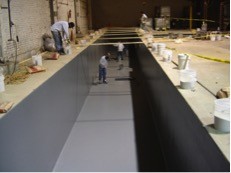Keeping track of your industrial operation’s unique epoxy flooring requirements can be a daunting task. However, proper physical assessment of each area of your industrial operation is an important part of a successful facilities maintenance program. Keeping a clear record of the various floor performance requirements throughout your facility can help in your capital epoxy flooring maintenance planning, as well as being able to properly communicate your unique needs to your flooring vendor and installer.
How to begin your analysis
When analyzing the flooring performance requirements for your facility, it is important to consider factors like the type of industrial activity, frequency of activity or traffic, type of machinery and equipment in use, potential chemical exposure, the likelihood of impact damage, slip resistance needs, electrostatic discharge concerns, thermal shock resistance, cleanliness standards and aesthetic considerations.
Carefully evaluating and documenting the specific demands placed on floors in all areas of your facility allows you to select the most appropriate and long-lasting flooring solutions to meet your industrial operation’s needs now and into the future. Proper planning and assessment ensures efficient, problem-free flooring maintenance over many years of use.
Performance Criteria to Consider for Each Unique Plant Area
Listed here are some common industrial flooring requirements that should be taken into consideration when developing a comprehensive floor maintenance initiative.
- Chemical Resistance Requirements
- Comprehensive list of all chemicals exposed to floor coating, including cleaning agents.
-
Potential concentrations and pH levels of chemical exposure.
-
Frequency and duration of exposure. This means occasional spillage, splash and spills or continuous immersion.
-
Degradation issues or common problem areas that have occurred in the past.
- Static Control Requirements
- Company EPA (Electrostatic Protected Area) Specification Requirements
- Static Dissipative or Conductive Designation
- Auditing and performance testing schedules
- Thermal Shock Requirements
-
Hot and cold water washdown temperatures and pressure
-
Live steam cleaning procedures and equipment
-
Temperature variations from internal and external sources
-
Thermal cycling from building access points
-
- Impact and Abrasion Requirements
-
Detailed listing of forklift and equipment information of what is used
-
Weight loads coming in contact with floor
-
High impact zones from drops or sliding equipment
-
Types of production materials for transport across floors
-
-
Hygiene and Cleanability Requirements
-
Hazard analysis plan requirements
-
Food safety requirements as needed
-
Specifications of cleaning per room or area of facility
-
Regulated concerns
-
- Ignition Risk Requirements
- Flammable chemical listing
- Dry goods/powders subject to ignition risk
- Aesthetic Requirements
- Light reflectivity needs
- Color coding requirements
- Decorative needs
- Safety Requirements
-
Degree of slip-resistance required for walkways
-
Traffic lines and zone markings
-
High-risk zones being labeled and having maximum grip
-
Post safety guides in dangerous areas
-
- General Requirements
- Desired surface texture (gloss, satin or dull)
- Ease of cleaning
- Ease of maintenance
Conclusion
By thoroughly evaluating current and future flooring needs for each facility zone, industrial managers can develop specialized flooring solutions tailored to their unique operational requirements. Partnering with experienced vendors and installers ensures proper material selection and preparation for long-lasting, high-performing epoxy floors.
When analyzing and documenting the range of performance criteria required for an industrial epoxy flooring solution, it becomes clear that a one-size-fits-all approach is not manageable. Careful consideration of chemical resistance, electrostatic, thermal, impact, cleanability, safety and aesthetic needs allows managers to create a customized flooring plan to match their specific production environment. Keeping comprehensive records of these facility analysis findings further aids in the capital planning and budgeting process for required flooring upgrades and replacements. With proactive planning and vigilance of problem areas, industrial managers can keep their unique floors protected and high functioning for years to come.
Does your industrial operation have various epoxy flooring requirements? Learn how we can help by downloading our FREE E-Guide “Polymer Flooring – One Solution Does Not Meet All of Your Industrial Needs”.
- A Faster Cure for Flooring Needs: Polyaspartics in Action - April 8, 2025
- The Case for Epoxy Mortar in Manufacturing - April 8, 2025
- Epoxy Mortar Flooring: Built for Heavy-Duty Performance - March 29, 2025




